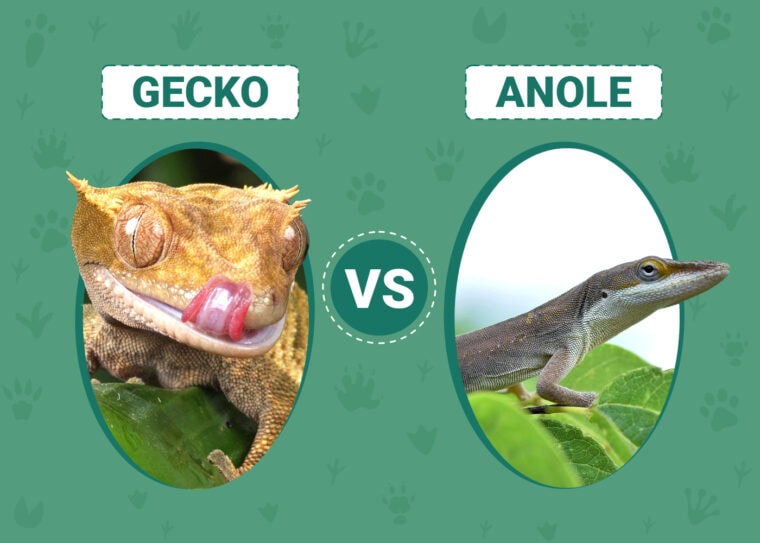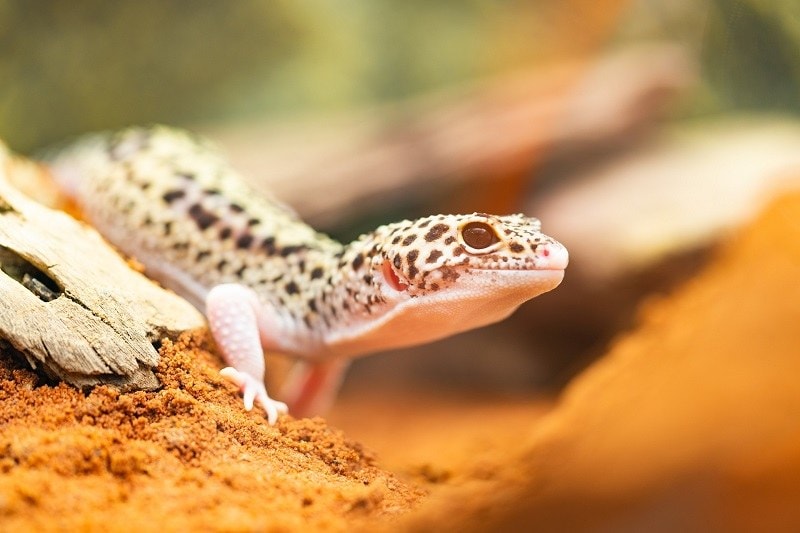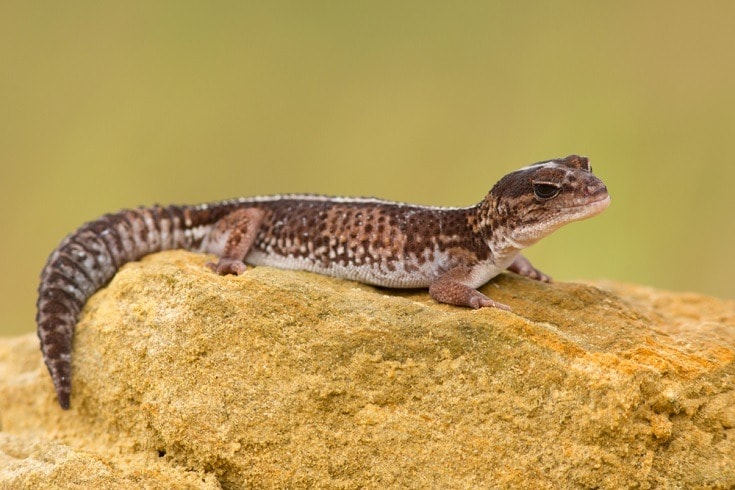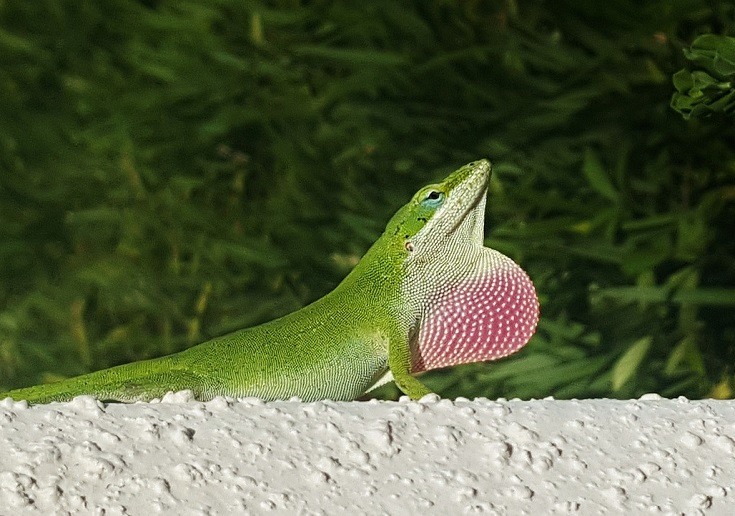
Click to Skip Ahead
When you’re choosing pets to put into your terrarium, you might want to know the key differences between a few popular choices. Both geckos and anoles are relatively easy to keep and are quite popular choices for first-time and seasoned reptile owners. If you do a little research, plan out a terrific set-up, and buy from a reputable breeder, either one can be an ideal pick.
If you don’t know much about either or want a breakdown of the differences, we will explore each lizard in-depth. You can get a basic understanding of care to decide what exciting reptile belongs in your set up.
Visual Differences

At A Glance
Gecko Overview

Geckos are small reptiles that you can find in warm climates worldwide—excluding Antarctica—in over 1,600 varieties. Though several types exist, you will find the leopard gecko and crested gecko most commonly in captivity.
Geckos can inhabit several different environments, making them highly adaptable and versatile. Usually, you can find them in rainforests, deserts, and mountains. They are nocturnal creatures who do most of their venturing during nighttime hours.
Geckos are known for their vocalizations, like chirping, clicking, and other peculiar sounds. They are calm and docile with people, but they might get aggressive in certain circumstances with each other.
Because of their bright colors, small stature, and favorably long lifespans, they’ve grown in popularity as prime reptile companions.
Sociability & Temperament
For reptiles, geckos are usually agreeable and slow-paced pets. They don’t mind being handled if you do it correctly without scaring them with quick movements. They are a bit sensitive, so being as calm as possible while holding them will keep them feeling secure and content.
While they don’t mind being held too much, you should always limit your time touching them. Geckos may become very stressed, which can cause them to fall ill. If you grab them by their tail, they might also snap it off as a defense.
Even though their tails can grow back, it’s a long process—and it can sometimes lead to infection. To keep your gecko happy and comfortable, limit handling time to 15 minutes a day or less.
Environmental Care
Geckos love a humid, moist environment that mimics their natural habitat. Having the proper temperatures and humidity in their terrarium helps their skin stay moist and shed appropriately. It also keeps their body temperature where it should be without getting too hot or cold.
In their cage, you should offer a hot and cool side so they can go where they need to be. On the cool side, temperatures should fall between 75-85 degrees Fahrenheit. The humidity level in the cage should be roughly 30% to 40%.
You can’t have tiny particles for substrate like sand because they can ingest it accidentally—but not digest it. So, it can cause them extreme difficulty and even lead to death. Always use reptile carpet, newspaper, or another flat surface for the bottom of the cage.
Geckos enjoy climbing around and basking on branches. They might also enjoy their hide to sleep or cool down. You must maintain the cage to cater to both of these needs so it doesn’t disrupt their natural sleep/wake cycle.

Health
Geckos require specific cage care to stay healthy. You might encounter some health issues which may outnumber those of an anole. However, they do have a longer lifespan.
Geckos have a hearty appetite, enjoying gut-filled insects like crickets and mealworms. You can occasionally add fruits and veggies into the diet, like carrots or apples—but they have to be in bite-sized bits. Healthy adults eat once every 2 days to maintain appropriate weight and nutrition.
You can add a water dish to the cage big enough for your gecko to submerge its body in. They need to be able to both drink and soak for optimal hydration and skin health. It would be best if you also misted the enclosure to keep the environment.
Geckos should stay moderately healthy, but their health can be temperamental if they aren’t properly cared for. You could see issues develop, such as:
Expenses
Starting your terrarium will be the most significant expense, and geckos are roughly $20 more expensive than anoles in themselves.
You will have to consider every aspect of owning a gecko, costs include but are not limited to:
The basics will cost roughly $250-$270. Once you have all of the necessary components, your monthly cost will decrease significantly.

Suitable for:
You can own a gecko if you’re a first-time reptile owner, but you really need to do your research first. Ensure that you understand just how to care for them and can afford all the supplies that tack on to the final cost.
Also, if you’re buying a gecko for your child, you’ll want to be sure that the child is old enough to handle and care for the lizard properly. If you worry that you aren’t quite ready for the responsibility, you might want to go for anole instead to start off.
Anole Overview

Anoles are small reptiles, related to the ever-popular iguana, but with a more compact look. Different kinds of anoles can be found in southern states of the US, Cuba, Jamaica, and the Caribbean Islands. These little tropical lizards love warm, humid climates and will need caged environments to closely mimic their natural habitats.
These little climbers love to spend their time crawling around on branches, walls, and other vertical planes. They don’t have to have cage mates but work very well in same-sex pairs or groups. Because they are generally easy to care for, they do very well in beginner households.
Even though these lizards are wonderful for first-time reptile owners, they still require proper care to live a long, healthy life. If you want a low-maintenance reptile that doesn’t require frequent handling, you might have everything you’re looking for in the green anole.
Sociability & Temperament
Green anoles can make fabulous pets for first time owners. However, that doesn’t mean that they come hassle-free. They still require particular care when they’re inside their enclosure. Green anoles might also be timid and shy.
They might scurry away from you instead of letting you hold them. For this reason, it is important to learn how to handle them by keeping them close.
Green anoles don’t really like to be held very much. So, it’s best to handle them minimally to avoid too much stress. If an anole is stressed out, they can drop their tail as a defense mechanism. When they do, it can cause infection—so always be gentle and mindful.
You can house green anoles together, but there should only be one male or multiple females. If you have more than one male in the same terrarium, they can start fighting or showing aggression towards one another, leading to battle wounds—so make sure you buy accordingly.
Environmental Care
Green anoles love a nice, toasty environment with plenty of moisture and ventilation. You want to have at least a 10-gallon cage for one and up the size for any additional cage mates that join in.
Having both a thermometer and humidity detector inside of the terrarium can help you monitor if conditions are right. The cage should be warmer at the top and cooler towards the floor so your anole can bask in the light or cool down as needed.
The top of the terrarium should be about 85 to 90 degrees, while the bottom should be 75-85 degrees Fahrenheit. Humidity levels should stay between 60% and 80%.

Health
When it comes to keeping your anole happy and ailment-free, cage conditions have to be ideal for them. Typically, sickness comes from a lack of proper care either in diet or surroundings. You can most commonly see a few health issues pop up in your anole—and most require veterinary attention.
Anoles absolutely love basking in the sun, so they benefit greatly from a heat lamp. However, they also need plenty of shade. Having a terrarium full of lush plants will help them feel right at home.
Anoles get most of their water from the droplets on plant leaves, so it’s essential to have enough greenery to suit their hydration needs, too. They also like a substrate of soil or peat moss.
Anoles love feasting on insects like mealworms or waxworms. It would be best if you never fed any lizard wild-caught insects because it can make them very sick.
Anoles are generally very healthy, but a poor environment may cause issues like:
Expenses
When you set up your terrarium, that will be the costliest part. You have to consider all of the components you will need to provide them a perfect environment. Costs include:
Initially, you’re looking at a starting cost of roughly $250. After the initial set up, you’ll only have to replace their food supply, and occasionally bedding or substrate.
Suitable for:
Green anoles are suitable for first-time owners who aren’t too familiar with reptiles. Always do your research to make sure that you are providing your annual with the correct environment. If you properly care for anole, they will live long lives—up to 8 years.

Gecko vs Anole: A Side-By-Side Comparison
- Related Read: Do Green Anoles Make Good Pets?
Which Type is Right For You?
Regardless of whether you have owned lizards in the past, each experience is different. It’s nice to get a breakdown of what the gecko and anole require so you know if you want to assume the responsibility. Because their care is so specific, it might seem a little overwhelming for a novice owner.
Just be sure to educate yourself in order to provide the right kind of atmosphere for your lizard. No matter if you choose the gecko or anole, you’ll have an interesting creature that will teach you all about what it’s like to have a cold-blooded pet. There’s nothing like hands-on experience!
Featured Image Credit: Top – torstensimon, Pixabay | Bottom – Brett_Hondow, Pixabay










